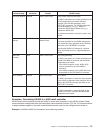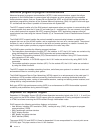
QPASVRP
Target 5250 display station pass-through primary server job. This job log is for target pass-through
communications functions.
QPASVRS
Target 5250 display station pass-through secondary server job. These contain more detailed
messages for target pass-through communication functions
Subsystem jobs (QINTER and QCMN)
Interactive subsystem and communication subsystem. These job logs are for subsystem jobs.
For more information on pass-through primary jobs, see the Remote Work Station Support
book.
Solving communication problems using communications trace
Sometimes, program debugging tasks are easier if you can trace the data that is sent and received on the
communications line or within the network server. To run a communications trace, use the following
commands:
STRSST (Start Service Tools)
The STRSST command takes you to a menu of tools to obtain error log information and
communications trace information. For a detailed description of system service tools, see: “System
service tools and communication problems” on page 82
STRCMNTRC (Start Communications Trace)
The STRCMNTRC command starts a communications trace for the specified line, network interface
description, or network server description. The communications trace continues until one of the
following occurs:
v The system runs the End Communications Trace (ENDCMNTRC) command
v A physical line problem causes the trace to end
v The Communications Trace function of the STRSST command ends the trace
v The *STOPTRC parameter is specified, and the buffer becomes full
ENDCMNTRC (End Communications Trace)
The ENDCMNTRC command ends the trace currently running on the specified line, network interface
description, or network server description. The ENDCMNTRC command saves the communications
trace buffer and the associated System Licensed Internal Code (SLIC) data.
PRTCMNTRC (Print Communications Trace)
The PRTCMNTRC command writes the communications trace data for the specified line, network
interface description, or network server description to a spooled file or a database file. The system can
print trace data multiple times in either form, and parameters on the command allow for dividing and
formatting of the data.
DLTCMNTRC (Delete Communications Trace)
The DLTCMNTRC command deletes the communications trace buffer and associated SLIC data for
the specified line, network interface description, or network server description. The communications
trace can be deleted once the trace has ended.
CHKCMNTRC (Check Communications Trace)
The CHKCMNTRC command returns the communications trace status for a specific line, network
interface description, or network server description. The CHKCMNTRC command returns status for all
of the traces of a specific type that exist on the system. The system returns the status through a
message.
TRCCPIC (Trace Common Programming Interface (CPI) Communications)
You can start to trace Common Programming Interface (CPI) Communications either before running a
job or after a job is active to find out where the error might have occurred. The TRCCPIC command
captures information about CPI-Communications calls that is processed by your program.
For more information on how to access System Service Tools, see the Backup and Recovery
book.
Chapter 8. Troubleshooting communications problems 81


















